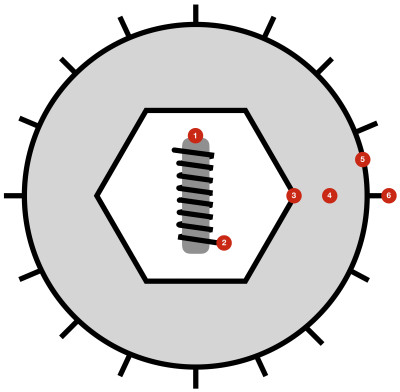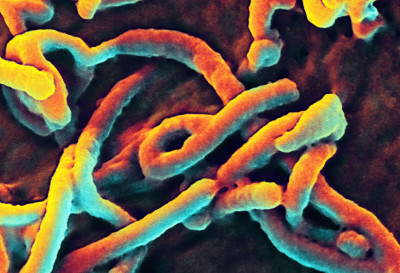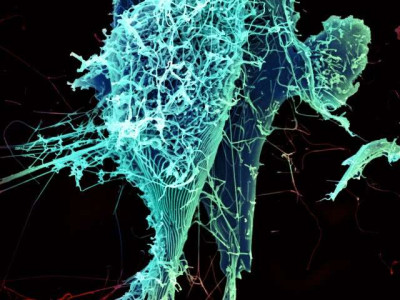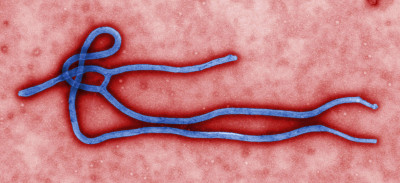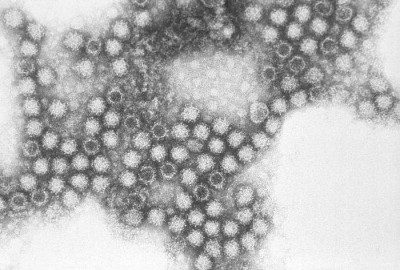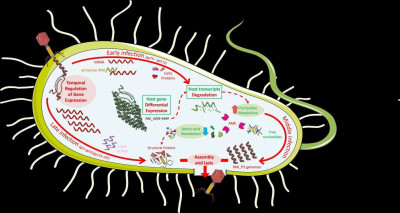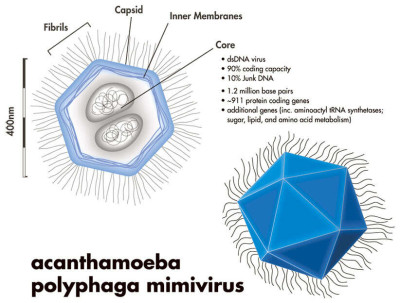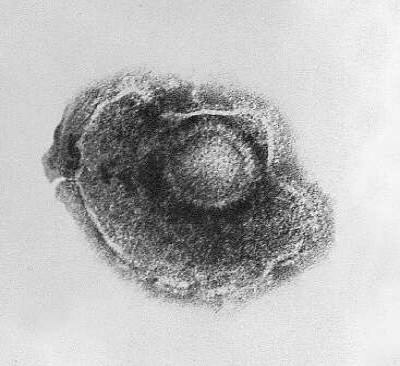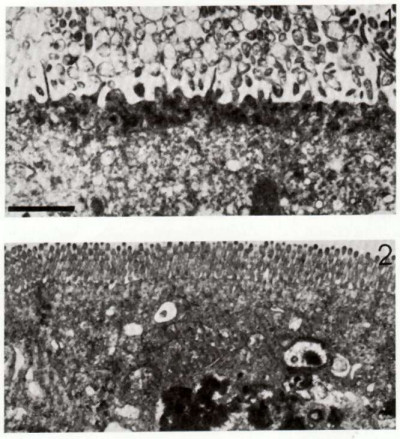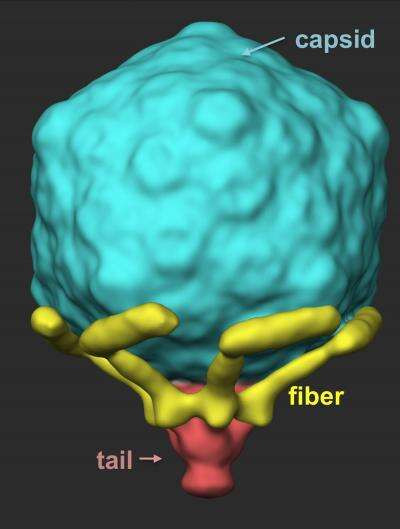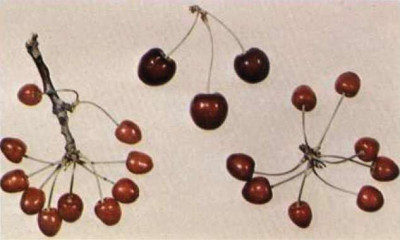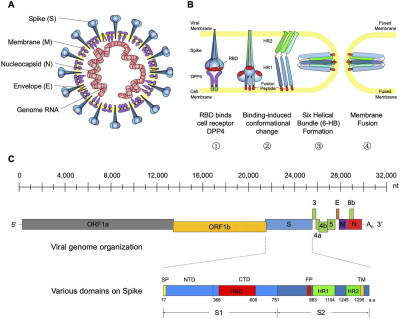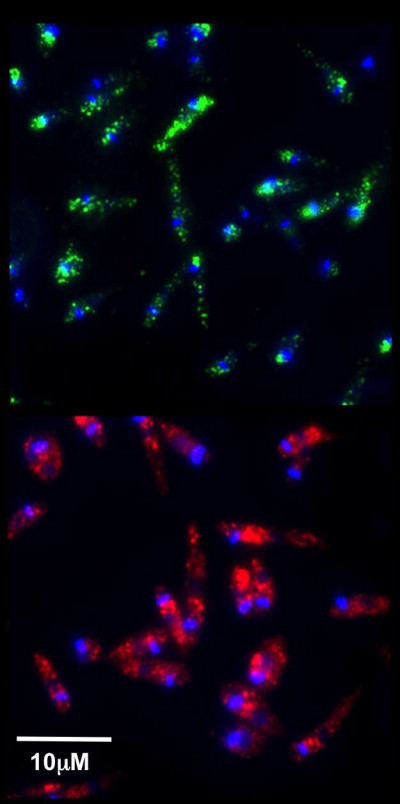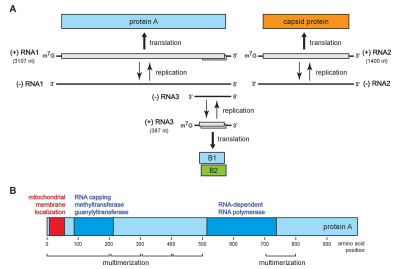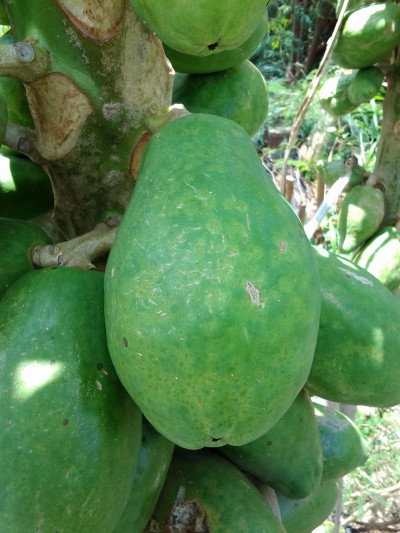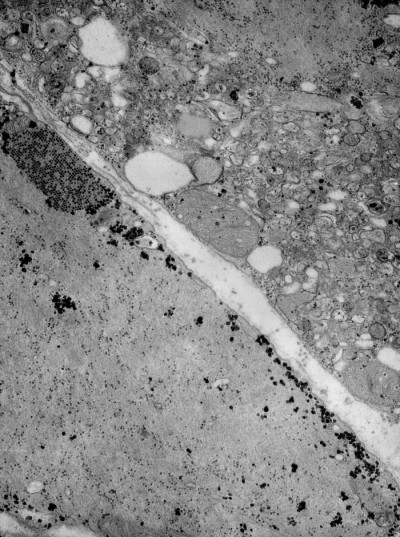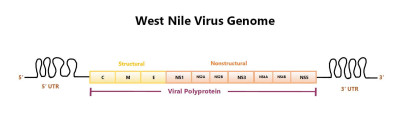Simplified diagram of Herpesvirales virion structure in cross-section. (1) nucleoprotein, (2) DNA, (3) capsid, (4) tegument, (5) envelope, (6) glycoprotein.
Ypna, Wikimedia Commons
01 Mar 2024
Flowchart showing the West Nile virus transmission cycle.
Wikimedia Commons, Centers for Disease Control and Prevention
02 Apr 2024
Scanning electron micrograph of Ebola virus budding from the surface of a Vero cell (African green monkey kidney epithelial cell line).
Wikimedia Commons
03 Apr 2024
String-like Ebola virus particles are shedding from an infected cell in this electron micrograph.
NIAID, Wikimedia Commons
24 Jan 2024
Ebola virus virion. Created by GC microbiologist Cynthia Goldsmith, this colorized transmission electron micrograph (TEM) revealed some of the ultrastructural morphology displayed by an Ebola virus virion.
Public Health Image Library (PHIL)
24 Jan 2024
This electron micrograph reveals the morphologic traits exhibited by the feline calicivirus (FCV), a Caliciviridae family member. Feline calicivirus virions average 35nm - 40nm in diameter, and exhibit cup-like surface depressions, which sometimes manifest as a "Star of David" array. The feline symptoms include upper respiratory symptoms with oral ulcerations, and pneumonitis.
Jessie
26 Jan 2024
This is a picture of the bacteriophage life cycle.
Anne Chevallereau and colleagues, Wikimedia Commons
31 Jan 2024
Observed at the Alverstone Mead Nature Reserve, a chaffinch eyes up potential food.
Wikimedia Commons, Peter Trimming
02 Feb 2024
An infographic / illustration of mimivirus, based upon various web-based sources, including giantvirus.org and Wikipedia.
Xanthine, Wikimedia Commons
22 Feb 2024
Electron micrograph of a Varicella (Chickenpox) Virus. Varicella or Chickenpox, is an infectious disease caused by the varicella-zoster virus, which results in a blister-like rash, itching, tiredness and fever.
CDC Public Health Image Library (PHIL),Wikimedia Commons
22 Feb 2024
Transmission electron micrograph of an enterocyte 3 days after infection by rotavirus (top). The microvilli have been destroyed. An unifected enterocyte is shown for comparison at the bottom. The bar = approx 500 nm.
Graham Beards, Wikimedia Commons
23 Feb 2024
The T7 virion has six tail fibers that are folded back against its capsid. The fibers extend as the virus locates a suitable host and as it "walks" across its host cell surface to find a site to infect.
Wikimedia Commons
01 Mar 2024
Lambert cherry fruit affected by little cherry, left and right, showing smaller size, duller color, and angular and pointed shape, compared with normal Lambert fruit, center.
Maurice F. Welsh and Philip W. Cheney, Wikimedia Commons
08 Mar 2024
General introduction to MERS-CoV: model structure, life cycle and genomic composition. (A) Cartoon model structure of MERS-CoV. (B) Membrane fusion mechanism for MERS-CoV spike glycoprotein. Binding between RBD and the cell receptor (DPP4) triggers the conformational change of S glycoprotein to form a pre-hairpin intermediate of S2, in which the hydrophobic HR1 is exposed and the fusion peptide inserts into the target cell membrane. This transient S2 intermediate then refolds with HR2 into a stabilized trimer of hairpins, also called six-helix bundle structure (6-HB), bringing the target cell membrane into close proximity of the viral envelope and resulting in the completion of the fusion process. (C) Genomic composition of MERS-CoV. Each coloured box (length in scale) represents one open reading frame in the genomic RNA. The schematic for spike glycoprotein was also shown with labelled domain names and residue numbers. ORF (open reading frame), DPP4 (dipeptidyl peptidase 4), RBD (receptor-binding domain), NTD (N-terminal domain), CTD (C-terminal domain), FP (fusion peptide), and HR1-2 (heptad repeats 1-2). [1]
Jiuyang Xu , Wenxu Jia, Pengfei Wang, Senyan Zhang, Xuanling Shi, Xinquan Wang & Linqi Zhang
11 Mar 2024
Leishmaniavirus (LRV1) detected in L. guyanensis parasites by immunofluorescence microscopy. Blue: DAPI-stained Leishmanial DNA Green: Antibody against dsRNA Red: Antibody against Leishmaniavirus capsid.
Wikimedia Commons, Mary-Anne Hartley
11 Mar 2024
Flock house virus genome organization and functional map of replicase protein A. (A) The bipartite FHV RNA genome encodes the viral replicase protein A on RNA1 and the capsid protein precursor on RNA2. Protein A mediates synthesis of a negative strand copy of the genomic RNAs which serves as template for synthesis of progeny positive strand RNAs, and an additional partial negative strand copy of RNA1 to template a 3’ co-terminal subgenomic RNA3. RNA3 potentially encodes protein B1, co-terminal with the C-terminus of protein A, and protein B2 which has anti-RNAi function. (B) A linear representation of protein A annotated to show membrane-association and enzymatic domains, and several regions independently capable of homotypic multimerization. [1]
Kenneth J Ertel, Desirée Benefield, Daniel Castaño-Diez, Janice G Pennington, Mark Horswill, Johan A den Boon, Marisa S Otegui, and Paul Ahlquist, Wikimedia Commons
13 Mar 2024
This diagram illustrates the methods by which the arbovirus, Western equine encephalitis virus (WEEV) reproduces and amplifies itself in both avian populations, and rodent populations, and is subsequently transmitted to dead end hosts including humans and horses by the Culex tarsalis mosquito. Western equine encephalitis virus, is a member of the family Togaviridae, and the genus Alphavirus, is closely related to Eastern and Venezuelan equine encephalitis viruses.
CDC/ Dr. Thomas Monath, Wikimedia Commons
15 Mar 2024
Ringspots on fruits.
Wikimedia Commons, Plant pests and diseases, Scot Nelson
15 Mar 2024
This transmission electron micrograph (TEM) revealed the presence of coxsackie B3 virus particles, which were found within a specimen of muscle tissue. coxsackie B3 virus is a member of the Picornaviridae family of viruses, and the genus, Enterovirus, as is the well-known, nearly eliminated, Poliovirus.
Public Health Image Library
02 Apr 2024
Depicts the RNA genome of the West Nile Virus including all of its genes and the 5' and 3' untranslated regions.
Wikimedia Commons, Puthuveetilnp
18 Apr 2024
 Encyclopedia
Encyclopedia
